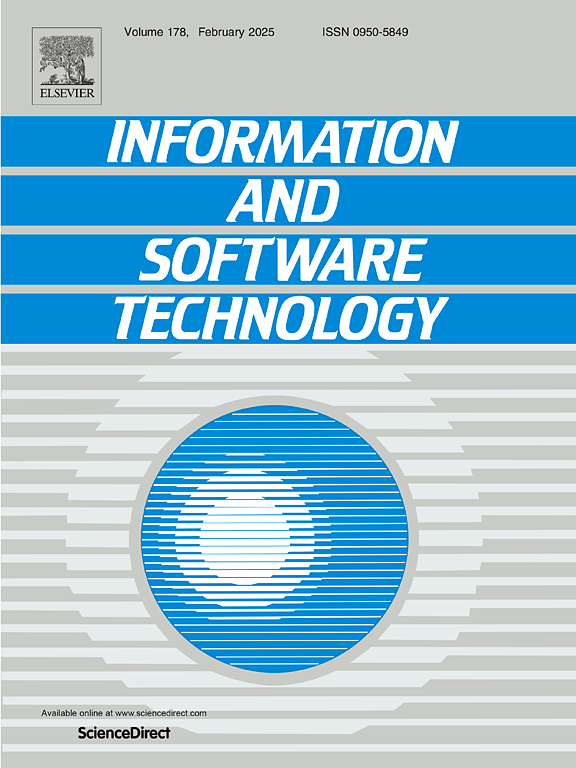A multivocal literature review on the benefits and limitations of industry-leading AutoML tools
IF 3.8
2区 计算机科学
Q2 COMPUTER SCIENCE, INFORMATION SYSTEMS
引用次数: 0
Abstract
Context:
Rapid advancements in Artificial Intelligence (AI) and Machine Learning (ML) are revolutionizing software engineering in every application domain, driving unprecedented transformations and fostering innovation. However, despite these advances, several organizations are experiencing friction in the adoption of ML-based technologies, mainly due to the current shortage of ML professionals. In this context, Automated Machine Learning (AutoML) techniques have been presented as a promising solution to democratize ML adoption, even in the absence of specialized people.
Objective:
Our research aims to provide an overview of the evidence on the benefits and limitations of AutoML tools being adopted in industry.
Methods:
We conducted a Multivocal Literature Review, which allowed us to identify 54 sources from the academic literature and 108 sources from the grey literature reporting on AutoML benefits and limitations. We extracted explicitly reported benefits and limitations from the papers and applied the thematic analysis method for synthesis.
Results:
In general, we identified 18 reported benefits and 25 limitations. Concerning the benefits, we highlight that AutoML tools can help streamline the core steps of ML workflows, namely data preparation, feature engineering, model construction, and hyperparameter tuning—with concrete benefits on model performance, efficiency, and scalability. In addition, AutoML empowers both novice and experienced data scientists, promoting ML accessibility. However, we highlight several limitations that may represent obstacles to the widespread adoption of AutoML. For instance, AutoML tools may introduce barriers to transparency and interoperability, exhibit limited flexibility for complex scenarios, and offer inconsistent coverage of the ML workflow.
Conclusion:
The effectiveness of AutoML in facilitating the adoption of machine learning by users may vary depending on the specific tool and the context in which it is used. Today, AutoML tools are used to increase human expertise rather than replace it and, as such, require skilled users.
关于业界领先的 AutoML 工具的优势和局限性的多语种文献综述
背景:人工智能(AI)和机器学习(ML)的快速发展正在彻底改变各个应用领域的软件工程,推动前所未有的变革并促进创新。然而,尽管取得了这些进步,一些组织在采用基于 ML 的技术时却遇到了摩擦,主要原因是目前缺乏 ML 专业人才。在这种情况下,自动机器学习(AutoML)技术被认为是即使在缺乏专业人员的情况下也能实现 ML 应用民主化的一种有前途的解决方案。我们从这些文献中提取了明确报告的优点和局限性,并采用专题分析法进行了综合。结果:总体而言,我们发现了 18 项报告的优点和 25 项局限性。关于益处,我们强调 AutoML 工具可以帮助简化 ML 工作流程的核心步骤,即数据准备、特征工程、模型构建和超参数调整,从而在模型性能、效率和可扩展性方面带来具体益处。此外,AutoML 还能帮助新手和有经验的数据科学家,提高 ML 的可及性。不过,我们也强调了一些可能阻碍 AutoML 广泛应用的局限性。例如,AutoML 工具可能会对透明度和互操作性造成障碍,在复杂场景下表现出有限的灵活性,并且对 ML 工作流的覆盖范围不一致。如今,AutoML 工具被用来提高人类的专业知识,而不是取而代之,因此需要熟练的用户。
本文章由计算机程序翻译,如有差异,请以英文原文为准。
求助全文
约1分钟内获得全文
求助全文
来源期刊

Information and Software Technology
工程技术-计算机:软件工程
CiteScore
9.10
自引率
7.70%
发文量
164
审稿时长
9.6 weeks
期刊介绍:
Information and Software Technology is the international archival journal focusing on research and experience that contributes to the improvement of software development practices. The journal''s scope includes methods and techniques to better engineer software and manage its development. Articles submitted for review should have a clear component of software engineering or address ways to improve the engineering and management of software development. Areas covered by the journal include:
• Software management, quality and metrics,
• Software processes,
• Software architecture, modelling, specification, design and programming
• Functional and non-functional software requirements
• Software testing and verification & validation
• Empirical studies of all aspects of engineering and managing software development
Short Communications is a new section dedicated to short papers addressing new ideas, controversial opinions, "Negative" results and much more. Read the Guide for authors for more information.
The journal encourages and welcomes submissions of systematic literature studies (reviews and maps) within the scope of the journal. Information and Software Technology is the premiere outlet for systematic literature studies in software engineering.
 求助内容:
求助内容: 应助结果提醒方式:
应助结果提醒方式:


